A Critical Evaluation of Leadership Theories and Change Management
VerifiedAdded on 2023/06/08
|6
|1269
|313
Homework Assignment
AI Summary
This assignment provides a critical evaluation of key leadership theories, including the trait theory and the nature vs. nurture argument, questioning the notion that 'true leaders are born.' It further analyzes Lewin's 3-phase model of change (unfreeze, change, refreeze), highlighting its strengths, weaknesses, and potential problems managers might face during implementation. The analysis considers the model's simplicity, stakeholder approach, rigidity, and limitations in handling complex changes, referencing academic sources to support the arguments presented. The assignment is intended to enhance understanding of leadership and change management principles.
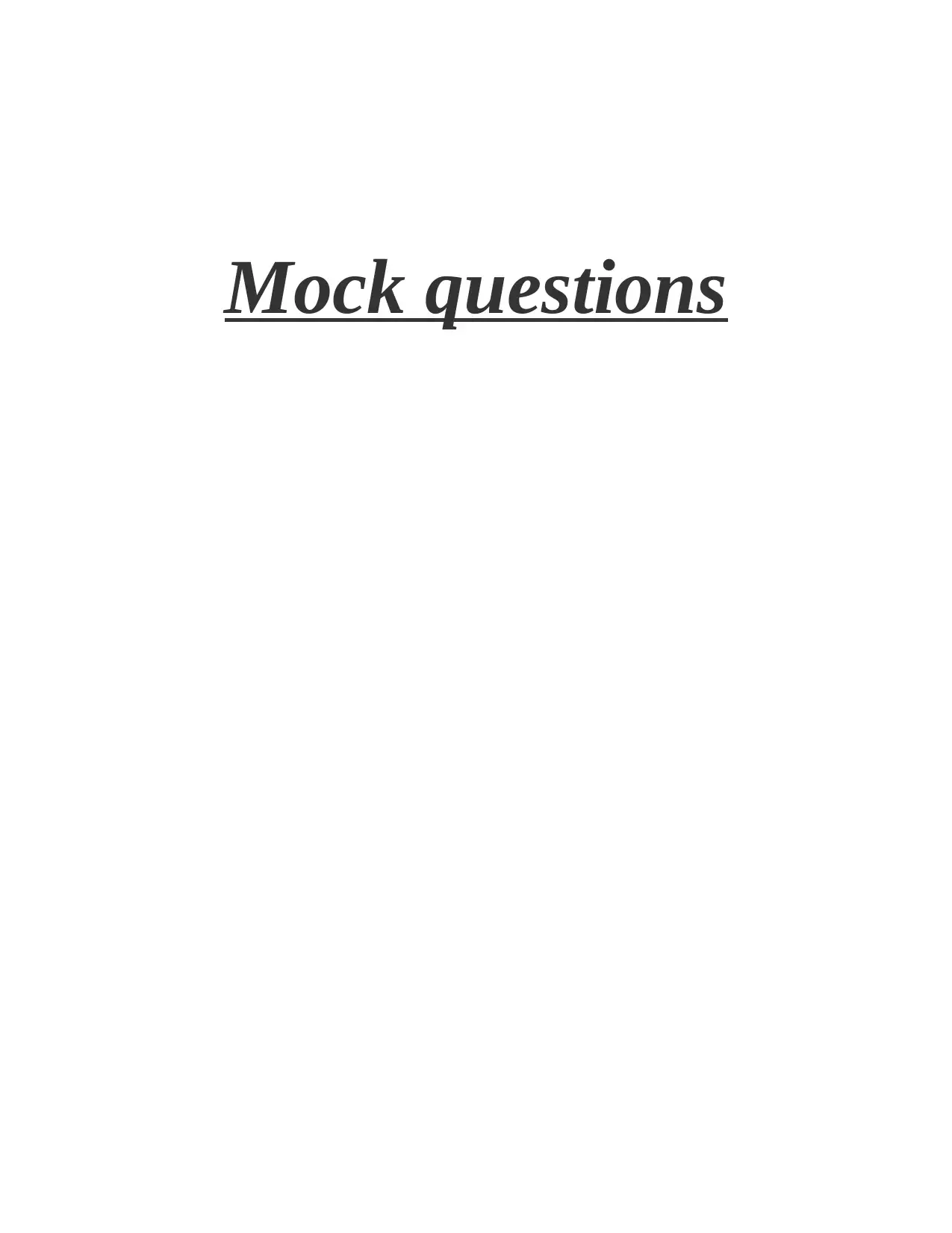
Mock questions
Paraphrase This Document
Need a fresh take? Get an instant paraphrase of this document with our AI Paraphraser

Contents
MAIN BODY..................................................................................................................................1
REFERENCES................................................................................................................................3
MAIN BODY..................................................................................................................................1
REFERENCES................................................................................................................................3
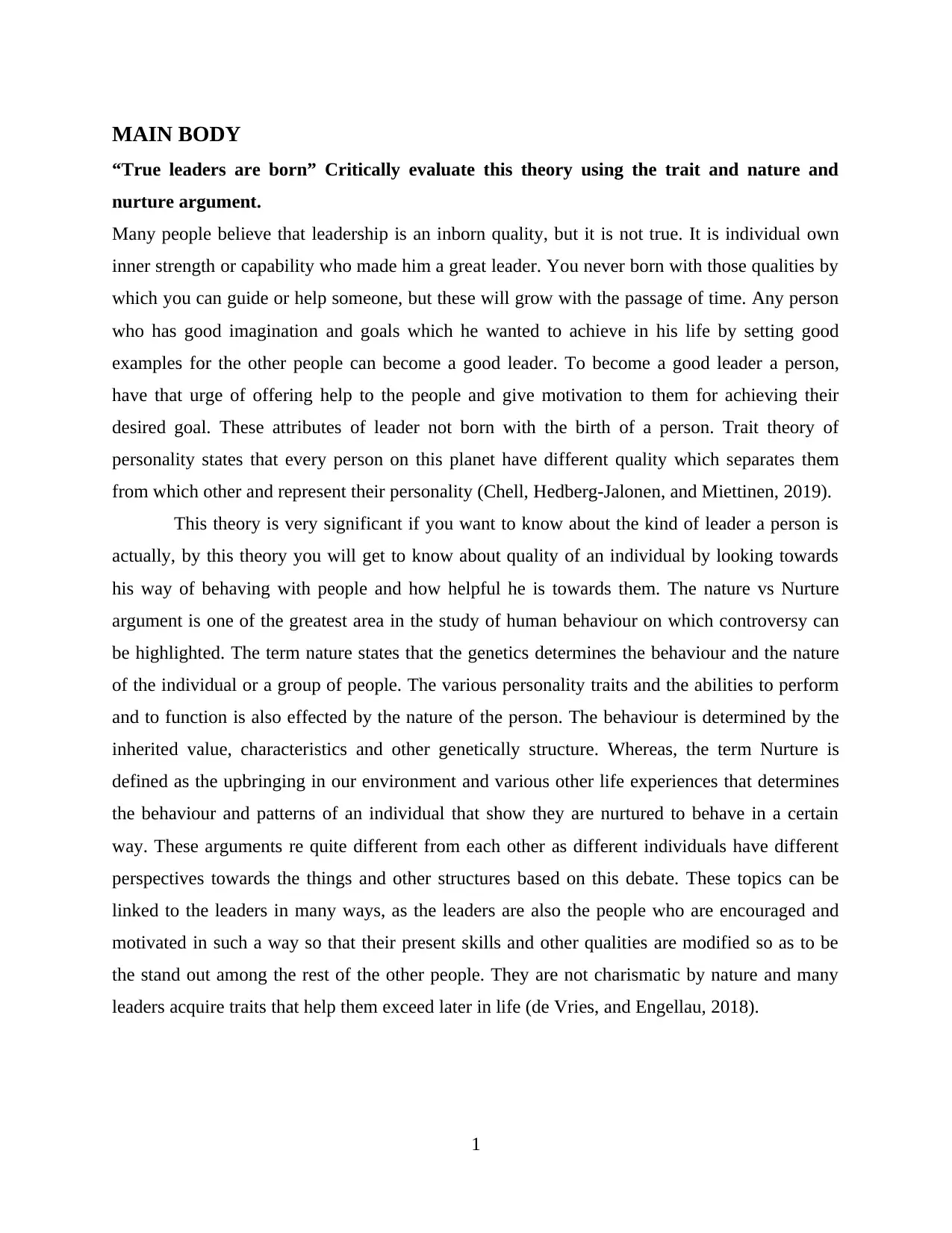
MAIN BODY
“True leaders are born” Critically evaluate this theory using the trait and nature and
nurture argument.
Many people believe that leadership is an inborn quality, but it is not true. It is individual own
inner strength or capability who made him a great leader. You never born with those qualities by
which you can guide or help someone, but these will grow with the passage of time. Any person
who has good imagination and goals which he wanted to achieve in his life by setting good
examples for the other people can become a good leader. To become a good leader a person,
have that urge of offering help to the people and give motivation to them for achieving their
desired goal. These attributes of leader not born with the birth of a person. Trait theory of
personality states that every person on this planet have different quality which separates them
from which other and represent their personality (Chell, Hedberg-Jalonen, and Miettinen, 2019).
This theory is very significant if you want to know about the kind of leader a person is
actually, by this theory you will get to know about quality of an individual by looking towards
his way of behaving with people and how helpful he is towards them. The nature vs Nurture
argument is one of the greatest area in the study of human behaviour on which controversy can
be highlighted. The term nature states that the genetics determines the behaviour and the nature
of the individual or a group of people. The various personality traits and the abilities to perform
and to function is also effected by the nature of the person. The behaviour is determined by the
inherited value, characteristics and other genetically structure. Whereas, the term Nurture is
defined as the upbringing in our environment and various other life experiences that determines
the behaviour and patterns of an individual that show they are nurtured to behave in a certain
way. These arguments re quite different from each other as different individuals have different
perspectives towards the things and other structures based on this debate. These topics can be
linked to the leaders in many ways, as the leaders are also the people who are encouraged and
motivated in such a way so that their present skills and other qualities are modified so as to be
the stand out among the rest of the other people. They are not charismatic by nature and many
leaders acquire traits that help them exceed later in life (de Vries, and Engellau, 2018).
1
“True leaders are born” Critically evaluate this theory using the trait and nature and
nurture argument.
Many people believe that leadership is an inborn quality, but it is not true. It is individual own
inner strength or capability who made him a great leader. You never born with those qualities by
which you can guide or help someone, but these will grow with the passage of time. Any person
who has good imagination and goals which he wanted to achieve in his life by setting good
examples for the other people can become a good leader. To become a good leader a person,
have that urge of offering help to the people and give motivation to them for achieving their
desired goal. These attributes of leader not born with the birth of a person. Trait theory of
personality states that every person on this planet have different quality which separates them
from which other and represent their personality (Chell, Hedberg-Jalonen, and Miettinen, 2019).
This theory is very significant if you want to know about the kind of leader a person is
actually, by this theory you will get to know about quality of an individual by looking towards
his way of behaving with people and how helpful he is towards them. The nature vs Nurture
argument is one of the greatest area in the study of human behaviour on which controversy can
be highlighted. The term nature states that the genetics determines the behaviour and the nature
of the individual or a group of people. The various personality traits and the abilities to perform
and to function is also effected by the nature of the person. The behaviour is determined by the
inherited value, characteristics and other genetically structure. Whereas, the term Nurture is
defined as the upbringing in our environment and various other life experiences that determines
the behaviour and patterns of an individual that show they are nurtured to behave in a certain
way. These arguments re quite different from each other as different individuals have different
perspectives towards the things and other structures based on this debate. These topics can be
linked to the leaders in many ways, as the leaders are also the people who are encouraged and
motivated in such a way so that their present skills and other qualities are modified so as to be
the stand out among the rest of the other people. They are not charismatic by nature and many
leaders acquire traits that help them exceed later in life (de Vries, and Engellau, 2018).
1
⊘ This is a preview!⊘
Do you want full access?
Subscribe today to unlock all pages.

Trusted by 1+ million students worldwide
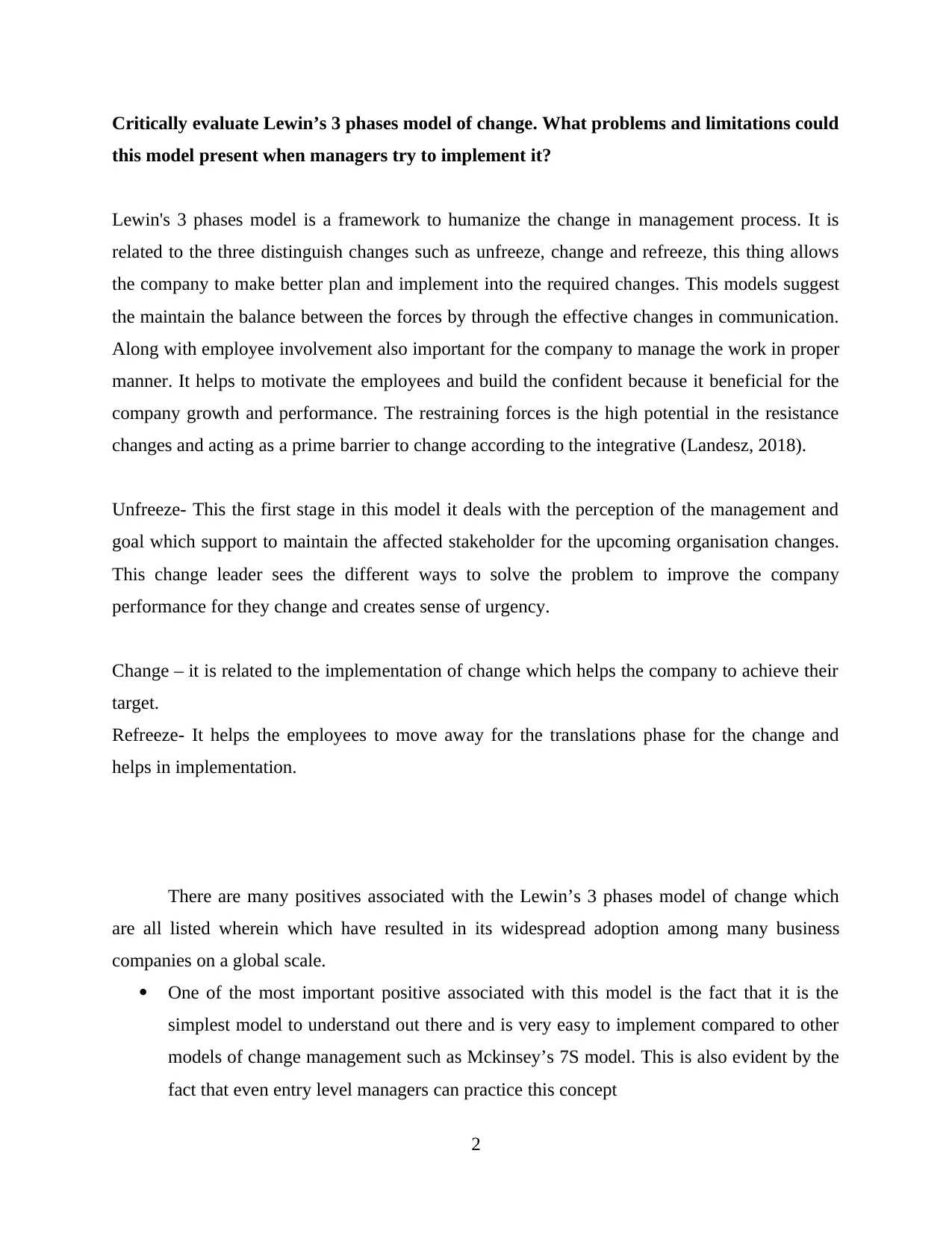
Critically evaluate Lewin’s 3 phases model of change. What problems and limitations could
this model present when managers try to implement it?
Lewin's 3 phases model is a framework to humanize the change in management process. It is
related to the three distinguish changes such as unfreeze, change and refreeze, this thing allows
the company to make better plan and implement into the required changes. This models suggest
the maintain the balance between the forces by through the effective changes in communication.
Along with employee involvement also important for the company to manage the work in proper
manner. It helps to motivate the employees and build the confident because it beneficial for the
company growth and performance. The restraining forces is the high potential in the resistance
changes and acting as a prime barrier to change according to the integrative (Landesz, 2018).
Unfreeze- This the first stage in this model it deals with the perception of the management and
goal which support to maintain the affected stakeholder for the upcoming organisation changes.
This change leader sees the different ways to solve the problem to improve the company
performance for they change and creates sense of urgency.
Change – it is related to the implementation of change which helps the company to achieve their
target.
Refreeze- It helps the employees to move away for the translations phase for the change and
helps in implementation.
There are many positives associated with the Lewin’s 3 phases model of change which
are all listed wherein which have resulted in its widespread adoption among many business
companies on a global scale.
One of the most important positive associated with this model is the fact that it is the
simplest model to understand out there and is very easy to implement compared to other
models of change management such as Mckinsey’s 7S model. This is also evident by the
fact that even entry level managers can practice this concept
2
this model present when managers try to implement it?
Lewin's 3 phases model is a framework to humanize the change in management process. It is
related to the three distinguish changes such as unfreeze, change and refreeze, this thing allows
the company to make better plan and implement into the required changes. This models suggest
the maintain the balance between the forces by through the effective changes in communication.
Along with employee involvement also important for the company to manage the work in proper
manner. It helps to motivate the employees and build the confident because it beneficial for the
company growth and performance. The restraining forces is the high potential in the resistance
changes and acting as a prime barrier to change according to the integrative (Landesz, 2018).
Unfreeze- This the first stage in this model it deals with the perception of the management and
goal which support to maintain the affected stakeholder for the upcoming organisation changes.
This change leader sees the different ways to solve the problem to improve the company
performance for they change and creates sense of urgency.
Change – it is related to the implementation of change which helps the company to achieve their
target.
Refreeze- It helps the employees to move away for the translations phase for the change and
helps in implementation.
There are many positives associated with the Lewin’s 3 phases model of change which
are all listed wherein which have resulted in its widespread adoption among many business
companies on a global scale.
One of the most important positive associated with this model is the fact that it is the
simplest model to understand out there and is very easy to implement compared to other
models of change management such as Mckinsey’s 7S model. This is also evident by the
fact that even entry level managers can practice this concept
2
Paraphrase This Document
Need a fresh take? Get an instant paraphrase of this document with our AI Paraphraser
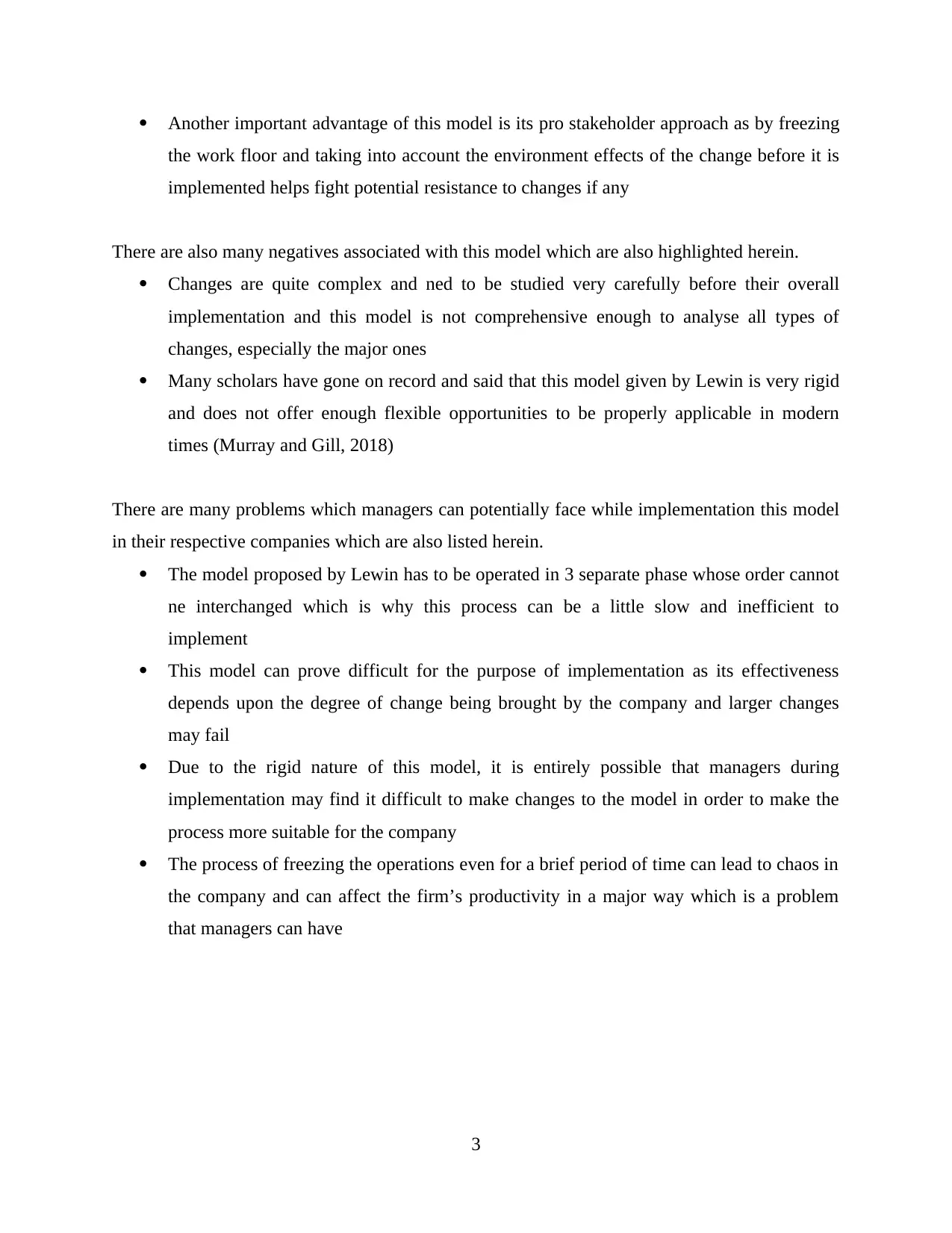
Another important advantage of this model is its pro stakeholder approach as by freezing
the work floor and taking into account the environment effects of the change before it is
implemented helps fight potential resistance to changes if any
There are also many negatives associated with this model which are also highlighted herein.
Changes are quite complex and ned to be studied very carefully before their overall
implementation and this model is not comprehensive enough to analyse all types of
changes, especially the major ones
Many scholars have gone on record and said that this model given by Lewin is very rigid
and does not offer enough flexible opportunities to be properly applicable in modern
times (Murray and Gill, 2018)
There are many problems which managers can potentially face while implementation this model
in their respective companies which are also listed herein.
The model proposed by Lewin has to be operated in 3 separate phase whose order cannot
ne interchanged which is why this process can be a little slow and inefficient to
implement
This model can prove difficult for the purpose of implementation as its effectiveness
depends upon the degree of change being brought by the company and larger changes
may fail
Due to the rigid nature of this model, it is entirely possible that managers during
implementation may find it difficult to make changes to the model in order to make the
process more suitable for the company
The process of freezing the operations even for a brief period of time can lead to chaos in
the company and can affect the firm’s productivity in a major way which is a problem
that managers can have
3
the work floor and taking into account the environment effects of the change before it is
implemented helps fight potential resistance to changes if any
There are also many negatives associated with this model which are also highlighted herein.
Changes are quite complex and ned to be studied very carefully before their overall
implementation and this model is not comprehensive enough to analyse all types of
changes, especially the major ones
Many scholars have gone on record and said that this model given by Lewin is very rigid
and does not offer enough flexible opportunities to be properly applicable in modern
times (Murray and Gill, 2018)
There are many problems which managers can potentially face while implementation this model
in their respective companies which are also listed herein.
The model proposed by Lewin has to be operated in 3 separate phase whose order cannot
ne interchanged which is why this process can be a little slow and inefficient to
implement
This model can prove difficult for the purpose of implementation as its effectiveness
depends upon the degree of change being brought by the company and larger changes
may fail
Due to the rigid nature of this model, it is entirely possible that managers during
implementation may find it difficult to make changes to the model in order to make the
process more suitable for the company
The process of freezing the operations even for a brief period of time can lead to chaos in
the company and can affect the firm’s productivity in a major way which is a problem
that managers can have
3
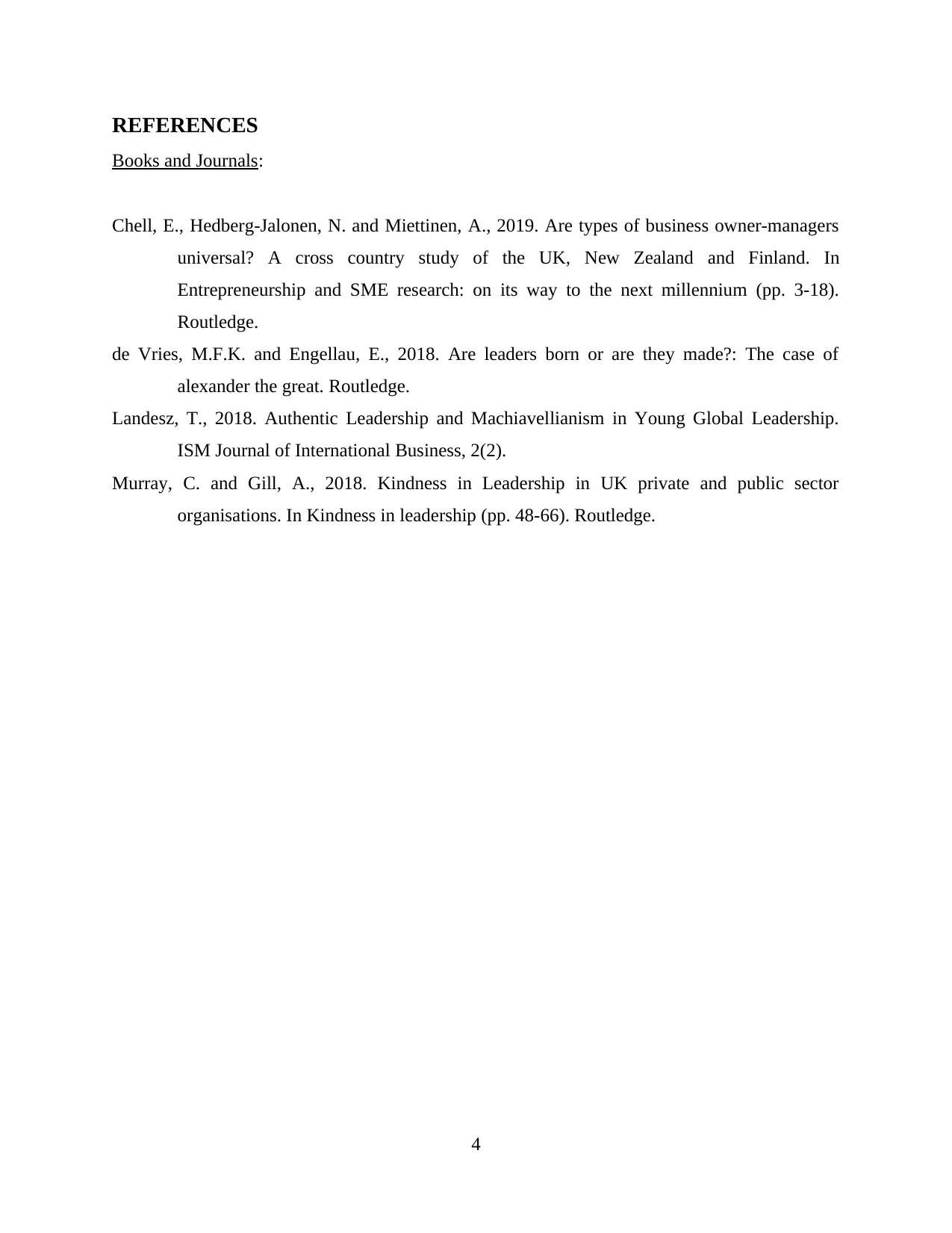
REFERENCES
Books and Journals:
Chell, E., Hedberg-Jalonen, N. and Miettinen, A., 2019. Are types of business owner-managers
universal? A cross country study of the UK, New Zealand and Finland. In
Entrepreneurship and SME research: on its way to the next millennium (pp. 3-18).
Routledge.
de Vries, M.F.K. and Engellau, E., 2018. Are leaders born or are they made?: The case of
alexander the great. Routledge.
Landesz, T., 2018. Authentic Leadership and Machiavellianism in Young Global Leadership.
ISM Journal of International Business, 2(2).
Murray, C. and Gill, A., 2018. Kindness in Leadership in UK private and public sector
organisations. In Kindness in leadership (pp. 48-66). Routledge.
4
Books and Journals:
Chell, E., Hedberg-Jalonen, N. and Miettinen, A., 2019. Are types of business owner-managers
universal? A cross country study of the UK, New Zealand and Finland. In
Entrepreneurship and SME research: on its way to the next millennium (pp. 3-18).
Routledge.
de Vries, M.F.K. and Engellau, E., 2018. Are leaders born or are they made?: The case of
alexander the great. Routledge.
Landesz, T., 2018. Authentic Leadership and Machiavellianism in Young Global Leadership.
ISM Journal of International Business, 2(2).
Murray, C. and Gill, A., 2018. Kindness in Leadership in UK private and public sector
organisations. In Kindness in leadership (pp. 48-66). Routledge.
4
⊘ This is a preview!⊘
Do you want full access?
Subscribe today to unlock all pages.

Trusted by 1+ million students worldwide
1 out of 6
Related Documents
Your All-in-One AI-Powered Toolkit for Academic Success.
+13062052269
info@desklib.com
Available 24*7 on WhatsApp / Email
![[object Object]](/_next/static/media/star-bottom.7253800d.svg)
Unlock your academic potential
Copyright © 2020–2025 A2Z Services. All Rights Reserved. Developed and managed by ZUCOL.





